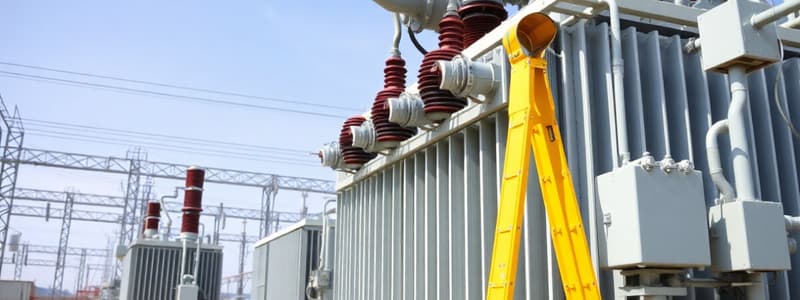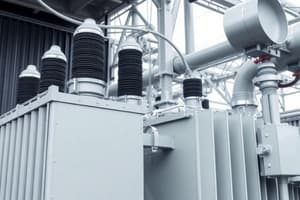Podcast
Questions and Answers
What is the primary function of an oil conservator in a transformer?
What is the primary function of an oil conservator in a transformer?
- To maintain a constant oil level and manage oil expansion. (correct)
- To detect gas leaks within the transformer.
- To cool the transformer through air circulation.
- To prevent mechanical damage during transportation.
Which device is crucial for preventing excessive internal pressure in a transformer tank?
Which device is crucial for preventing excessive internal pressure in a transformer tank?
- Pressure relief valves. (correct)
- Oil filler fittings.
- Cooling tubes.
- Gaskets and seals.
What is the initial step in calculating cooling tubes for a transformer?
What is the initial step in calculating cooling tubes for a transformer?
- Determine heat load. (correct)
- Select cooling method.
- Check for adequate cooling.
- Calculate required cooling capacity.
Which of the following is NOT a feature typically found on a transformer tank?
Which of the following is NOT a feature typically found on a transformer tank?
What is the significance of painting and coating a transformer tank?
What is the significance of painting and coating a transformer tank?
What is the primary function of the primary winding in a transformer?
What is the primary function of the primary winding in a transformer?
What distinguishes three-phase transformer windings from single-phase transformer windings?
What distinguishes three-phase transformer windings from single-phase transformer windings?
How does the number of turns in the secondary winding affect a transformer?
How does the number of turns in the secondary winding affect a transformer?
What is a unique feature of an auto-transformer compared to traditional transformers?
What is a unique feature of an auto-transformer compared to traditional transformers?
Which type of winding arrangement is known for better insulation and a compact design?
Which type of winding arrangement is known for better insulation and a compact design?
What is the main characteristic of high-voltage (HV) windings in transformers?
What is the main characteristic of high-voltage (HV) windings in transformers?
Which material provides higher conductivity for transformer windings but may be more expensive?
Which material provides higher conductivity for transformer windings but may be more expensive?
What is the purpose of sandwich winding in a transformer?
What is the purpose of sandwich winding in a transformer?
What shape do the windings take in a Delta connection?
What shape do the windings take in a Delta connection?
Which factor is essential for determining the turns ratio in a transformer?
Which factor is essential for determining the turns ratio in a transformer?
What is the primary purpose of the no-load current in a transformer?
What is the primary purpose of the no-load current in a transformer?
What is the relationship between the magnetizing reactance (Xm) and the no-load current (I no-load)?
What is the relationship between the magnetizing reactance (Xm) and the no-load current (I no-load)?
What type of core is typically used in transformer design for better magnetic coupling?
What type of core is typically used in transformer design for better magnetic coupling?
Which of the following is NOT a primary consideration when designing a transformer?
Which of the following is NOT a primary consideration when designing a transformer?
What is a key characteristic of the primary winding in a transformer?
What is a key characteristic of the primary winding in a transformer?
What happens when the secondary winding of a transformer is open-circuited?
What happens when the secondary winding of a transformer is open-circuited?
Which of the following factors influences the choice of core material in transformer design?
Which of the following factors influences the choice of core material in transformer design?
What do core losses in a transformer primarily consist of?
What do core losses in a transformer primarily consist of?
What does the turns ratio in a transformer represent?
What does the turns ratio in a transformer represent?
How are the primary and secondary winding currents related?
How are the primary and secondary winding currents related?
What is leakage flux in transformers?
What is leakage flux in transformers?
What is the effect of resistance and leakage reactance in a transformer?
What is the effect of resistance and leakage reactance in a transformer?
The frequency of the AC supply affects which component of the transformer?
The frequency of the AC supply affects which component of the transformer?
What occurs to the voltage transformation ratio when N2 is greater than N1?
What occurs to the voltage transformation ratio when N2 is greater than N1?
What type of forces primarily act within a transformer?
What type of forces primarily act within a transformer?
What does the RMS value of induced emf in the primary winding depend on?
What does the RMS value of induced emf in the primary winding depend on?
In a practical transformer, what happens to the self-induced emf due to leakage flux?
In a practical transformer, what happens to the self-induced emf due to leakage flux?
What is the average induced emf per turn in terms of frequency and flux?
What is the average induced emf per turn in terms of frequency and flux?
What causes mechanical stresses within a transformer during a short circuit?
What causes mechanical stresses within a transformer during a short circuit?
What is the primary function of transformer oil in oil-immersed cooling?
What is the primary function of transformer oil in oil-immersed cooling?
Which cooling method uses forced air to improve heat exchange in transformers?
Which cooling method uses forced air to improve heat exchange in transformers?
What component is typically included within a transformer tank for safety monitoring?
What component is typically included within a transformer tank for safety monitoring?
What design consideration helps ensure the structural integrity of a transformer tank?
What design consideration helps ensure the structural integrity of a transformer tank?
What happens when the magnetic core of a transformer saturates?
What happens when the magnetic core of a transformer saturates?
Which of these methods involves cooling transformers using water?
Which of these methods involves cooling transformers using water?
What does the thermal cycling of a transformer typically result in?
What does the thermal cycling of a transformer typically result in?
In which cooling method does natural convection play a key role?
In which cooling method does natural convection play a key role?
What type of construction method is commonly used for transformer tanks?
What type of construction method is commonly used for transformer tanks?
Flashcards
Primary Winding
Primary Winding
The coil that receives electrical power from the source, connected to the input voltage.
Secondary Winding
Secondary Winding
The coil delivering electrical power to the load, connected to the device needing power.
Single-Phase Transformer
Single-Phase Transformer
A transformer with one primary and one secondary winding, common in household and small businesses.
Three-Phase Transformer
Three-Phase Transformer
Signup and view all the flashcards
Auto-Transformer
Auto-Transformer
Signup and view all the flashcards
Concentric Winding
Concentric Winding
Signup and view all the flashcards
HV Winding
HV Winding
Signup and view all the flashcards
Copper Winding
Copper Winding
Signup and view all the flashcards
Delta Connection
Delta Connection
Signup and view all the flashcards
Star (Wye) Connection
Star (Wye) Connection
Signup and view all the flashcards
Transformer Design Considerations
Transformer Design Considerations
Signup and view all the flashcards
Transformer Specifications
Transformer Specifications
Signup and view all the flashcards
No-load current
No-load current
Signup and view all the flashcards
Magnetizing Reactance (Xm)
Magnetizing Reactance (Xm)
Signup and view all the flashcards
Primary Winding
Primary Winding
Signup and view all the flashcards
Secondary Winding
Secondary Winding
Signup and view all the flashcards
Turns Ratio
Turns Ratio
Signup and view all the flashcards
Transformer Core
Transformer Core
Signup and view all the flashcards
Turns Ratio
Turns Ratio
Signup and view all the flashcards
Voltage Transformation
Voltage Transformation
Signup and view all the flashcards
Current Relationship
Current Relationship
Signup and view all the flashcards
Leakage Flux
Leakage Flux
Signup and view all the flashcards
Leakage Reactance
Leakage Reactance
Signup and view all the flashcards
Transformer Impedance
Transformer Impedance
Signup and view all the flashcards
EMF Equation
EMF Equation
Signup and view all the flashcards
Voltage Transformation Ratio (K)
Voltage Transformation Ratio (K)
Signup and view all the flashcards
Step-Up Transformer
Step-Up Transformer
Signup and view all the flashcards
Step-Down Transformer
Step-Down Transformer
Signup and view all the flashcards
Oil Conservator Function
Oil Conservator Function
Signup and view all the flashcards
Pressure Relief Device Purpose
Pressure Relief Device Purpose
Signup and view all the flashcards
Transformer Tank Cooling Calculation
Transformer Tank Cooling Calculation
Signup and view all the flashcards
Transformer Tank Testing Importance
Transformer Tank Testing Importance
Signup and view all the flashcards
Transformer Tank Protection
Transformer Tank Protection
Signup and view all the flashcards
Short-Circuit Forces
Short-Circuit Forces
Signup and view all the flashcards
Thermal Stresses
Thermal Stresses
Signup and view all the flashcards
Load Currents
Load Currents
Signup and view all the flashcards
Fault Currents
Fault Currents
Signup and view all the flashcards
Core Saturation
Core Saturation
Signup and view all the flashcards
Transformer Oil Cooling
Transformer Oil Cooling
Signup and view all the flashcards
Oil Forced Air Cooling
Oil Forced Air Cooling
Signup and view all the flashcards
Transformer Tank Material
Transformer Tank Material
Signup and view all the flashcards
Transformer Tank Shape
Transformer Tank Shape
Signup and view all the flashcards
Buchholz Relay
Buchholz Relay
Signup and view all the flashcards





